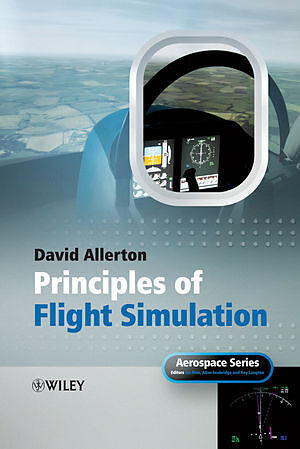Principles of Flight Simulation
Einband:
Fester Einband
EAN:
9780470754368
Untertitel:
Aerospace Series (PEP)
Genre:
Maschinenbau
Autor:
David (Sheffield University) Allerton
Herausgeber:
John Wiley & Sons Inc
Auflage:
1. Auflage
Anzahl Seiten:
496
Erscheinungsdatum:
09.10.2009
ISBN:
978-0-470-75436-8
Principles of Flight Simulation is a comprehensive guide to flight simulator design, covering the modelling, algorithms and software which underpin flight simulation. The book covers the mathematical modelling and software which underpin flight simulation.
Autorentext
David Allerton is Professor of Computer Systems Engineering in the Department of Automatic Control and Systems Engineering at the University of Sheffield. He is a Fellow of the Royal Aeronautical Society (FRAeS) and the Institution of Electrical Engineers (FIEE). He has been a Lecturer at the University of Southampton and the Professor of Avionics at Cranfield University. He has served on several national committees and is a member and past-Chairman of the Royal Aeronautical Society's Flight Simulation Group.
Inhalt
About the Author. Preface. Glossary . 1 Introduction. 1.1 Historical Perspective. 1.2 The Case for Simulation. 1.3 The Changing Role of Simulation. 1.4 The Organization of a Flight Simulator. 1.5 The Concept of Real-time Simulation. 1.6 Pilot Cues. 1.7 Training versus Simulation. 1.8 Examples of Simulation. References. 2 Principles of Modelling. 2.1 Modelling Concepts. 2.2 Newtonian Mechanics. 2.3 Axes Systems. 2.4 Differential Equations. 2.5 Numerical Integration. 2.6 Real-time Computing. 2.7 Data Acquisition. 2.8 Flight Data. 2.9 Interpolation. 2.10 Distributed Systems. 2.11 A Real-time Protocol. 2.12 Problems in Modelling. References. 3 Aircraft Dynamics. 3.1 Principles of Flight Modelling. 3.2 The Atmosphere. 3.3 Forces. 3.4 Moments. 3.5 Axes Systems. 3.6 Quaternions. 3.7 Equations of Motion. 3.8 Propulsion. 3.9 The Landing Gear. 3.10 The Equations Collected. 3.11 The Equations Revisited - Long Range Navigation. References. 4 Simulation of Flight Control Systems. 4.1 The Laplace Transform. 4.2 Simulation of Transfer Functions. 4.3 PID Control Systems. 4.4 Trimming. 4.5 Aircraft Flight Control Systems. 4.6 The Turn Coordinator and the Yaw Damper. 4.7 The Auto-throttle. 4.8 Vertical Speed Management. 4.9 Altitude Hold. 4.10 Heading Hold. 4.11 Localizer Tracking. 4.12 Auto-land Systems. 4.13 Flight Management Systems. References. 5 Aircraft Displays. 5.1 Principles of Display Systems. 5.2 Line Drawing. 5.3 Character Generation. 5.4 D Graphics Operations. 5.5 Textures. 5.6 OpenGL(r). 5.7 Simulation of Aircraft Instruments. 5.8 Simulation of EFIS Displays. 5.9 Head-up Displays. References. 6 Simulation of Aircraft Navigation Systems. 6.1 Principles of Navigation. 6.2 Navigation Computations. 6.3 Map Projections. 6.4 Primary Flight Information. 6.5 Automatic Direction Finding (ADF). 6.6 VHF Omnidirectional Range (VOR). 6.7 Distance Measuring Equipment (DME). 6.8 Instrument Landing Systems (ILS). 6.9 The Flight Director. 6.10 Inertial Navigation Systems. 6.11 Global Positioning Systems. References. Further Reading. 7 Model Validation. 7.1 Simulator Qualification and Approval. 7.2 Model Validation Methods. 7.3 Latency. 7.4 Performance Analysis. 7.5 Longitudinal Dynamics. 7.6 Lateral Dynamics. 7.7 Model Validation in Perspective. References. 8 Visual Systems. 8.1 Background. 8.2 The Visual System Pipeline. 8.3 3D Graphics Operations. 8.4 Real-time Image Generation. 8.5 Visual Database Management. 8.6 Projection Systems. 8.7 Problems in Visual Systems. References. 9 The Instructor Station. 9.1 Education, Training and Instruction. 9.2 Part-task Training and Computer-based Training. 9.3 The Role of the Instructor. 9.4 Designing the User Interface. 9.5 Real-time Interaction. 9.6 Map Displays. 9.7 Flight Data Recording. 9.8 Scripting. References. 10 Motion Systems. 10.1 Motion or No Motion? 10.2 Physiological Aspects of Motion. 10.3 Actuator Configurations. 10.4 Equations of Motion. 10.5 Implementation of a Motion System. 10.6 Hydraulic Actuation. 10.7 Modelling Hydraulic Actuators. 10.8 Limitations of Motion Systems. 10.9 Future Motion Systems. References. Index.

Leider konnten wir für diesen Artikel keine Preise ermitteln ...
billigbuch.ch sucht jetzt für Sie die besten Angebote ...
Die aktuellen Verkaufspreise von 6 Onlineshops werden in Realtime abgefragt.
Sie können das gewünschte Produkt anschliessend direkt beim Anbieter Ihrer Wahl bestellen.
Loading...
Die aktuellen Verkaufspreise von 6 Onlineshops werden in Realtime abgefragt.
Sie können das gewünschte Produkt anschliessend direkt beim Anbieter Ihrer Wahl bestellen.
| # | Onlineshop | Preis CHF | Versand CHF | Total CHF | ||
|---|---|---|---|---|---|---|
| 1 | Seller | 0.00 | 0.00 | 0.00 |
